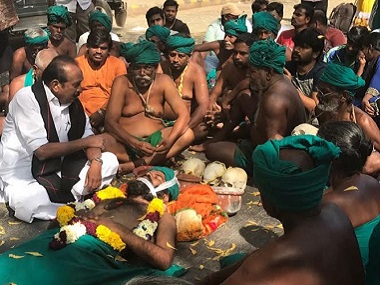What sort of desperation pushes someone to play dead for an entire day? Lying still, mouth tied with a cloth, surrounded by skulls and bones.
Reinforcing the funereal air at Delhi’s Jantar Mantar are close to 80-odd farmers from Tamil Nadu who, wearing a single piece of cloth, are mock-wailing around a ‘dead’ body.
It has been nearly two weeks since this group of farmers from Tamil Nadu came to New Delhi, after realising that their home state does not care about them. Not that the country’s capital does either, but Jantar Mantar is considered the hub for all protests.
The farmers have attracted some media attention, albeit because of the macabre sight of the skulls and bones – reportedly of other farmers from Tamil Nadu who killed themselves. Over 270 farmers in Tamil Nadu have reportedly committed suicide or have died of natural causes since October.
Earlier, the same group of farmers, mainly from the Cauvery Delta districts, had tried gimmicks like standing in the river water all day or protesting by keeping alive or dead rats in their mouths outside the Trichy collectorate in Tamil Nadu in December.
They repeated the ‘rats for breakfast’ act for shock value in the Capital on Monday. Wearing loincloth, they even climbed the trees at Jantar Mantar in order to attract attention. Basically, anything to grab the mindspace of the Lutyens’ political class.
But beyond the novelty of their protests, that made for some interesting photo-ops, it did little to get them any relief. Farmer deaths continue to be reduced to statistics, an apathetic way of dealing with a very real human crisis.
The Tamil Nadu government had asked for a loan waiver and other relief measures to the tune of Rs 39,000 crore from the Centre. But the High Level committee of the Union government last week approved a financial assistance of Rs 2,014 crore, which though the highest among the amounts given to ten drought-affected states, did not make the farmers happy.
They argue that apart from compensation to the farmers, the lower riparian state also deserves funds to build projects to be water sustainable. The standoff with Karnataka every year over the Cauvery river means that the Tamil Nadu farmer gets short shrift.
The plight of the farmers did not start yesterday. Thanks to the ugly legal battle between Karnataka and Tamil Nadu over the release of the Cauvery water in September last year, the farmers lost much of their kuruvai (summer) crop.
What made it worse was the fact that the northeast monsoon, which gives Tamil Nadu its maximum rainfall, failed between October and December. The monsoon deficit, of 62 percent, was the worst in a century, with the state receiving only 166 mm of rainfall against the seasonal average of 437 mm. The samba (winter) crop also failed as a result.
But the political establishment was hardly there to lend a shoulder. The period coincided with the hospitalisation and subsequent demise of state chief minister J Jayalalithaa and the political establishment got busy playing its own games.
January saw a massive uprising at the Marina beach in Chennai, where through the main focus was on lifting the ban on Jallikattu, an attempt was made to get everyone’s attention on the severe drought and suicides by the farmers.
But, barring the state government acknowledging 17 deaths and the National Human Rights Commission (NHRC) sending a notice to the government, nothing much happened. The unofficial death toll by experts stood at over 100 in January.
Over the past few days, Opposition leaders and even members of the film fraternity, like Prakash Raj and Vishal, have visited Jantar Mantar to lend support to the protesting farmers. They have refused to call off their stir unless loans from nationalised banks are written off, like those from cooperative banks were, when Jayalalithaa was CM.
Leader of Opposition in Tamil Nadu, MK Stalin, had even suggested to Chief Minister Edappadi Palaniswami to visit New Delhi, to lend support to the farmers and take up their cause, instead of campaigning for the RK Nagar bypoll.
But the problem with the ruling AIADMK is that it is constantly in a political firefighting mode. If all of February was spent in keeping its flock of MLAs guarded, dealing with the adverse court verdict that sent its leader VK Sasikala to jail and ensuring it won the trust vote, March has been spent preparing for the all-important bypoll, that could make or mar this government. The plight of the farmers is hardly on the regime’s agenda, leaving them to fight their own battle.
Lok Sabha deputy speaker M Thambidurai is the only senior AIADMK leader taking up the farmer cause in Delhi. The present AIADMK leadership, after the events of February, also suffers from a lack of connect with the men who matter in the BJP; which is why despite having close to 40 MPs, it is unable to leverage its political clout to get what it needs.
In this Jantar Mantar atmosphere of gloom, the hope expressed by Prime Minister Narendra Modi in February last year, that income of farmers will double by 2022, seems rather out of place. Particularly when the same kind of agrarian crisis also exists in north Karnataka and the Rayalaseema region of Andhra Pradesh.
Farm activists point out that the farmer has little support as the price of cultivation of most crops is more than the maximum selling price. Little attention is paid to minor irrigation projects or water harvesting methods, which means the farmer ends up reaching out to the noose in a bad monsoon year.
What the Tamil Nadu farmers have done, by escalating the crisis situation, is to literally ask the heart of India to choose what it wants: Food or skulls.


)




)
)
)
)
)
)